We already had one instance of Bitcoin being artificially manipulated upwards, in 2013, and most people who bought in got screwed. At the time, the fraud was happening on MtGox, an exchange that was processing over half of all trading volume, and was in a position to manipulate the market.
Today, over 70% of Bitcoin trading is happening against USDT, a stablecoin that’s being printed out of thin air at an exponential rate. People who are still buying Bitcoin with real dollars, now that everyone has understood the scheme, are simply the greatest fools who allow the scammers to cash out, right before the collapse.
The best performing asset in the world
If you think Bitcoin is the best performing asset right now, think again. You’re going to kick yourself for missing this one:
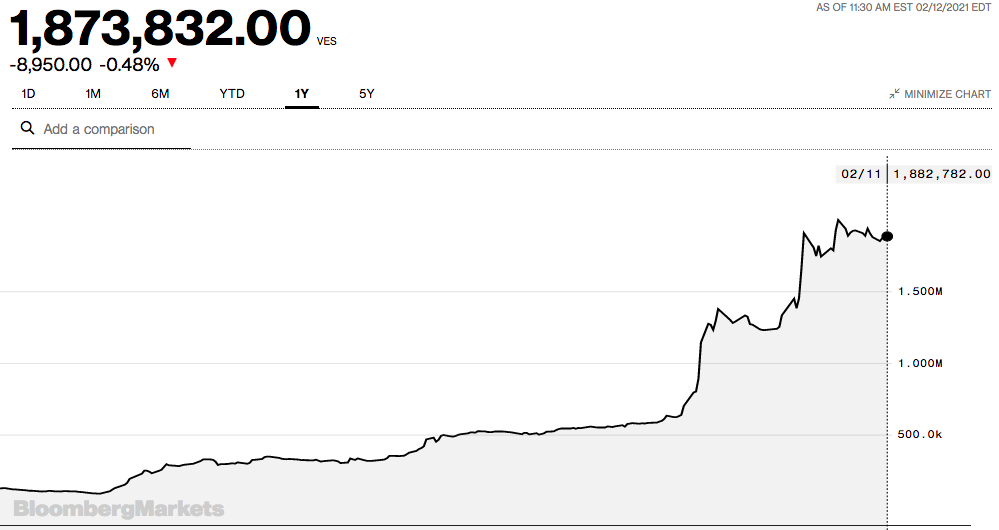
Yes, it’s a one year chart, and the asset in question is really up 2,300,000% over the last year. That’s two million three hundred thousand percent ARR. And it’s not some unknown painting that turned out to be a Da Vinci, that only an insider could buy before it mooned. No, it’s a stock index, everything is legit, the chart is from Bloomberg. And I can guarantee you that if you buy in today, you’re still early. It will continue to moon next year as well.
The chart above is that of the Caracas Stock Exchange Stock Market Index. You might have noticed that it’s denominated in VES, or Venezuelan Bolivar, a currency that’s going to lose half its value before the end of the day, as a result of relentless money printing by the Venezuelan central bank.
You can check the stock prices of any country with high inflation - from Zimbabwe to Argentina - and you’ll notice the same pattern, over and over again. “Money printer goes brrr” makes asset prices denominated in that currency go to the moon, and it’s never too late to join the party.
Obviously investing in Venezuelan or Zimbabwean equities won’t make you a billionaire in a few month’s time. The falling value of the currency will offset the gains, and you’ll end up holding some rather illiquid stocks that will be worth… probably something, but not billions of US dollars.
In the past, Venezuelan government officials tried to hide this reality by setting an “official” rate for the bolivar against the US dollar. Of course, you couldn’t buy any dollars with your bolivar at that rate, but for someone who wasn’t paying attention, it might have looked like things weren’t that bad.
You could, of course, buy bolivars with your dollars at that rate, but nobody was that stupid. Venezuelans knew the truth, because they were witnessing that the value of the bolivar was plummeting: a bag of carrots at the market would cost a thousand of bolivars one day, and two thousands the day after, and so forth.
A Potemkin village of a market
But what if you couldn’t buy anything with your bolivars, but the stock market? What if the Venezuelan government had such a tight grip on appearances, and on places that traded the bolivar, that you wouldn’t know the truth, at least for a while? You’d only see a chart that’s mooning, and only hear about people buying in because it was mooning, and those people would seem to be making stupid amounts of money day after day.
If you think this is impossible, google “Willy Bot“. At the time, the online exchange MtGox was an absolute leader in Bitcoin trading, with over half of all worldwide trading volume. You would wire your dollars to MtGox, receive MtGox credits in your account, that everyone believed to be worth their face value in USD, and buy Bitcoin with them. Bitcoin went up as if on steroids, and nobody questioned the goose that laid golden eggs.
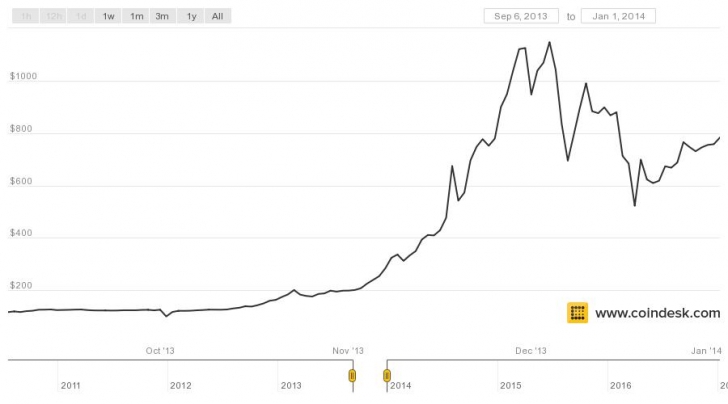
Until too many people tried to cash out, and MtGox went bust. You might notice that the price of Bitcoin didn’t crash that much afterwards, for the very simple reason that the exchange froze everyone’s accounts. Nobody was allowed to access their Bitcoins once the truth was out. Bitcoin not crashing to zero is little solace when you lost yours.
This was the exact same scenario as described with the imaginary all-powerful Venezuelan government - a central party (MtGox a.k.a. the Venezuelan government) that’s able to distort the perception of reality and print its way to the moon, attracting hordes of wannabe millionaires. Until one investor too many try to cash out and everything collapses.
Fool me once…
Surely that couldn’t happen again, people aren’t THAT stupid, right?
Well, it’s happening again. Over 70% of Bitcoin is traded against USDT, a stablecoin that’s being printed at an exponentially growing rate:
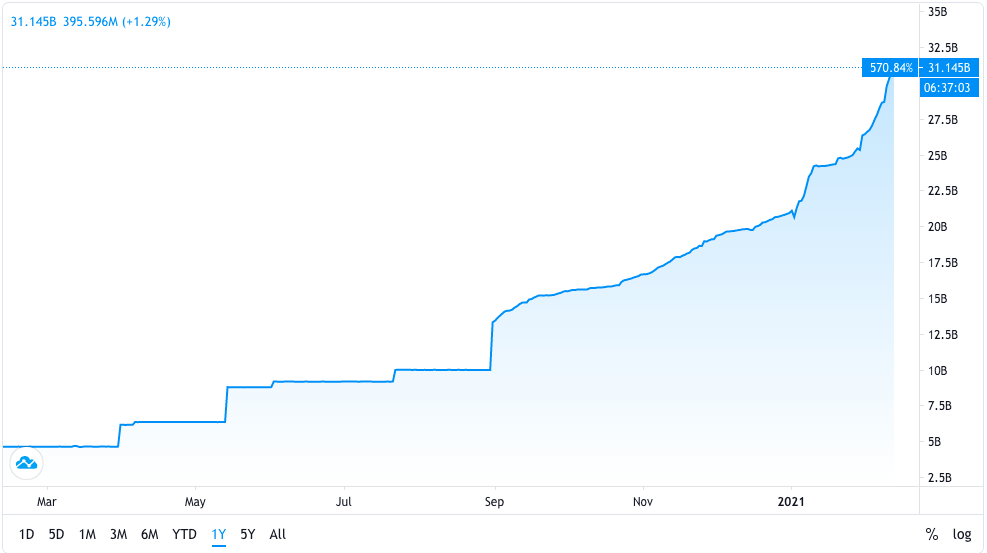
There are no basis for believing that USDT tokens are worth anything. USDTs are issued by Tether, a shady company whose legally declared office doesn’t exist, and that’s being investigated by the NYAG for fraud. Legally, USDTs are worthless: only a few selected secret parties can ask to redeem them for US dollars, and even then, Tether has the right to delay the redemption requests for as long as they want:
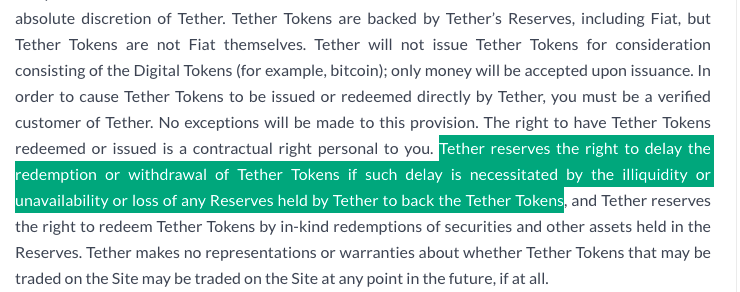
You cannot buy anything with USDTs but cryptocurrencies - mainly Bitcoin. There is no reason to believe that USDTs aren’t printed out of thin air: Tether has systematically failed to provide an audit of its reserves, and they won’t even say what those reserves are. Cryptocurrency macro flows show that USDTs are most probably backed by Bitcoins themselves, meaning that USDTs are issued to buy Bitcoin, thus pumping Bitcoin’s price.
The problem with USDTs being backed by Bitcoins is that Bitcoin can’t fall, or USDTs will no longer be properly backed, and exchanges will panic. This forces Tether to keep printing ever more USDTs to pump Bitcoin’s price, in an exponential race to the death until exchanges can no longer maintain the USDT peg because people who made millions of paper gains try to cash out - albeit a little bit, and everyone realises USDTs were just a fancy version of the Venezuelan bolivar.
However, as long as the day is young and there are more real USD buyers than USD sellers, the scammers can cash out for real dollars. The mechanics of the scheme are simple:
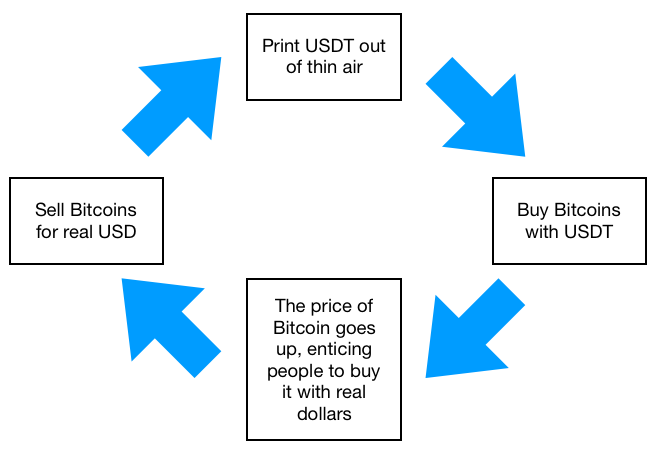
The rising price fallacy
With Bitcoin going up by 20% every month, a lot of people might be tempted to think, “hey, even if it’s a Ponzi scheme, it only needs to go on for a few more months and I’ll double my money, and then I’ll cash out before it collapses”.
But that’s the thing with fake markets - most people lose all their money, because most people don’t manage to cash out before the scheme collapses. The moment the inflows of USDs start to dwindle, the scammers close shop and disappear. Remember - these scammers have painstakingly put the scheme together with only one goal: get as much real dollars as possible, by selling you Bitcoins they’ve purchased with worthless tokens. They will not give a penny of their loot back, the moment they think their scheme is unraveling.
If you aren’t an insider, you have no way of knowing when that will happen, so your decision of buying in or cashing out is taken randomly. If you don’t have any insider information, you become part of the statistic. And statistics say that 99% of people will lose everything, and that you will almost certainly be in that 99%.
The rising price fallacy is the misconception that the longer a scheme goes up in price, the lower are the chances of it crashing in the near future. The reality is the exact opposite: the scheme has to suck in a lot of fools to establish that upward price chart, and by the time you, a random person with no inside information, has noticed it, most people are already invested, and you’ll just be part of the final herd.
Of course everybody thinks that they’re special, that they’re not part of the herd, that they’re smarter than the rest. That’s why the scam works. Because people need to rationalise the fact that they’re smarter than the rest, the founding pillar of Bitcoin communication is, “you’re still early”, and “more people are coming”. Much has been said about Tesla buying $1.5 billion worth of Bitcoin. But nobody is talking about the fact that someone has SOLD Tesla $1.5 billion worth of Bitcoin. Why has someone sold $1.5 billion worth of Bitcoin? Weren’t THEY aware of the fact that Bitcoin can only go up?

Nobody is talking about the crash to come, precisely because everyone invested knows that it’s a manipulated market, and they are hoping to cash out before the others. So the last thing everyone wants to do, is say anything that might make the other investors doubt, which could make those investors think about cashing out before they do. The tale of Emperor’s New Clothes is as old as civilization itself.
The endgame is simple: for everyone who is buying in, people are cashing out. Those who are cashing out, are part of the 1% who won’t lose it all. Statistically, you aren’t part of them.
